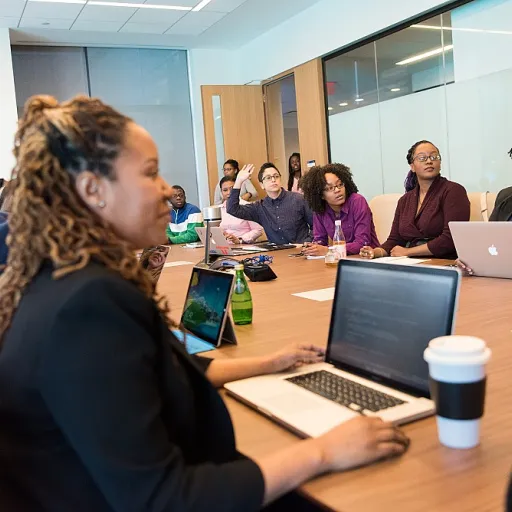
The Evolving Role of Staff Coordination
Adapting to New Forms of Coordination
In the ever-evolving landscape of work, team coordination has taken on a dynamic role. As companies transition towards hybrid work models, the way team members and staff engage in both office environments and remote settings requires thorough adaptation. Coordination is no longer limited to explicit planning and scheduling; it has expanded to include various forms of internal communication and task management. The shift towards hybrid work environments accentuates the need for clear communication and robust collaboration tools. These tools ensure every team member, whether working remotely or in-office, remains aligned and engaged with their roles and responsibilities. The process involves more than just implementing new software; it requires a fundamental rethink of roles and team structures. This means moving towards a more flexible approach where coordination and collaboration can occur seamlessly across different mediums. Rising to the challenges of this modern work environment, businesses are focusing on improving team coordination by incorporating effective project and time management strategies. The emphasis is on creating an enriched work environment where both implicit and explicit coordination methods play a pivotal role. Hybrid teams often face unique challenges that require innovative solutions in order to thrive, including adopting various types of team structures to suit specific needs and contexts. For a deeper understanding of how these changes are shaping future work environments, you can explore insights on key players in communication planning for future work environments. Understanding the interplay between team dynamics and coordination strategies is essential for any company aiming to enhance their collaborative efforts.Technological Innovations in Team Collaboration
Technological Advancements Revolutionizing Team Dynamics
As workplaces continue to evolve, the integration of technology is becoming an indispensable aspect of team coordination. The advent of new tools and platforms is reshaping how team communication and collaboration are facilitated, offering innovative ways for teams to coordinate effectively in both traditional and hybrid work environments.
One of the most significant technological influences is the proliferation of collaboration tools designed to streamline internal communication and enhance team management. Platforms that support project management tasks, such as Trello, Asana, and Microsoft Teams, allow team members to maintain clear channels of communication, which is crucial for efficient coordination hybrid arrangements. These tools enable seamless event and task planning, integrating various roles and responsibilities within the team dynamic.
Furthermore, the rise of hybrid work has necessitated the development of solutions that bridge the gap between remote and in-office staff coordination. Video conferencing solutions like Zoom and Google Meet play a pivotal role in ensuring explicit coordination, facilitating real-time interaction among team members regardless of their physical location. This virtual face-to-face communication is an essential component in sustaining effective team interaction and maintaining organizational coherence.
The use of artificial intelligence and machine learning technologies is also gaining traction in areas such as task automation, predictive analytics, and resource management. By automating routine responsibilities, staff can focus on more nuanced aspects of their roles, leading to an improved team working process. AI-powered tools can dynamically adjust workloads and predict future staffing needs, thereby optimizing the allocation of team resources.source
As technology continues to advance, its role will only become more critical, offering teams new possibilities for enhancing coordination and driving productivity in the evolving workplace landscape.
Challenges in Remote Staff Coordination
Navigating the Pitfalls of Remote Coordination
Remote work scenarios bring with them unique sets of challenges, especially in the realm of staff coordination. As companies increasingly adopt hybrid work models, effective team coordination becomes essential to maintain productivity and engagement. In a hybrid environment, clear communication and explicit coordination are crucial. Team members may be spread across various locations and time zones, making it challenging to streamline task management and ensure all roles and responsibilities are clearly defined. The disparity in time zones demands careful event planning and coordination to ensure meetings and project deadlines align without overburdening any team member. Another critical challenge is the limited social interaction that remote and hybrid teams often experience. This lack of face-to-face communication can lead to misinterpretations or gaps in internal communication, hindering collaboration among team members. Tools that facilitate seamless virtual interactions, like video conferencing and project management platforms, play a vital role in bridging these gaps. By leveraging such technological innovations in team collaboration, companies can foster an environment where implicit coordination and clear communication thrive. Moreover, maintaining team coordination in a hybrid work setup often demands that staff members develop new routines and adapt to different tools and processes. This adaptability ensures ongoing alignment with the company's objectives and facilitates a smooth workflow, even when team members are remote. The transition to hybrid work models highlights the need for enhanced planning and management. By recognizing and addressing these challenges, businesses can improve team dynamics and bolster overall productivity in the complex landscape of hybrid teams. To delve deeper into strategies for overcoming these coordination hurdles, you may explore more insights on this evolving topic by visiting here.Strategies for Effective Team Communication
Implementing Effective Communication Strategies
Effective team communication is a cornerstone of successful team coordination in modern work environments, especially as companies increasingly shift toward hybrid models. A primary goal is to ensure that every team member is clear on their roles and responsibilities. To this end, deliberate efforts in improving internal communication are essential.
To foster an environment where communication thrives, organizations must invest in tools that streamline these processes. Technologies like project management software can boost transparency and coordination across teams. These tools help track tasks, manage timelines, and provide a platform for open dialogues, thus enhancing team collaboration.
Another important aspect revolves around regular event planning that involves team coordination with both hybrid teams and those fully remote. These events can range from routine check-ins to quarterly reviews, helping maintain an ongoing communication loop between team members and leadership. Regular, explicit communication helps align project goals and ensures that all staff members are on the same page, thereby maximizing team performance.
Establishing clear communication processes within a hybrid work model also requires attention to implicit coordination. Implicit coordination involves understanding team dynamics and leveraging the preferred communication styles of different team types. For instance, some members might thrive with visual aids, while others prefer detailed written instructions.
Ultimately, a company's ability to adapt its communication strategies to its unique work environment will lay the foundation for improved collaboration and success.
Building a Collaborative Culture
Fostering a Unified Vision
Creating a collaborative culture in a team transcends basic communication and coordination. In an era where hybrid work models are becoming the norm, ensuring that every team member feels part of a cohesive unit is crucial. This culture is built on a foundation of clear communication and shared goals that align with the company's objectives.
Recognizing Roles and Responsibilities
Establishing defined roles and responsibilities within teams is essential for effective coordination. Each staff member needs to know not only their tasks but also how their role supports the broader company mission. This alignment helps reinforce a sense of purpose and direction, minimizing confusion over who does what and optimizing the workflow.
Nurturing Open and Effective Communication
Open internal communication channels are vital. Management should promote dialogue that is open and encourages the exchange of ideas. With various technological tools at our disposal, facilitating both explicit coordination and implicit coordination among team members can enhance collaboration.
Encouraging Innovative Team Processes
Encouraging innovation within team processes fosters a work environment that thrives on creativity and adaptability. Using digital tools to streamline processes, whether it's project management software or other coordination tools, can greatly improve how tasks are managed and executed, particularly in a hybrid work environment.
Promoting Flexibility and Adaptability
Creating a culture that values flexibility allows team members to adapt to changes seamlessly. As organizations shift to more dynamic working modes, accommodating a versatile schedule shows trust and empowers teams to function at their best.
Cultivating Trust and Engagement
Ultimately, a collaborative culture hinges on cultivating trust. When team members trust their peers and management, engagement and morale rise. Through regular event planning and opportunities for social interaction, teams can strengthen their bonds, making remote or hybrid setups feel personal and engaging.
Future Trends in Staff Coordination
Embracing Future Dynamics in Coordination
The landscape of staff coordination is set to transform with evolving work environments and hybrid models. As boundaries between physical and virtual offices blur, the requirement for adept team coordination becomes even more crucial. A shift in how work environments are crafted emphasizes seamless integration of technology, dynamic roles, and fluid responsibilities. To adapt, organizations must ensure their team members are well-versed with hybrid work environments and adept at navigating the complexities of both implicit and explicit coordination. This means fostering clear communication channels and using tools that enhance coordination. The introduction of sophisticated project management tools can aid in streamlining tasks and ensuring each team member understands their roles and responsibilities.- Technology Tailoring: The adoption of AI and collaborative platforms will play an increasing role in managing the coordination process. Companies must not only invest in these tools but train their teams to exploit their full potential for effective team communication.
- Flexible Work Practices: With the rise of hybrid teams, the rigidity of traditional work structures needs rethinking. Planning events, task assignments, and communication inline with individual team members' specific skills and work preferences can lead to improved coordination.
- Cultural Inclusivity: Establishing a work environment that encourages diverse thinking yet aligns with the company’s values can significantly enhance collaboration. Facilitating regular feedback sessions and open communication lines among all members is vital.












